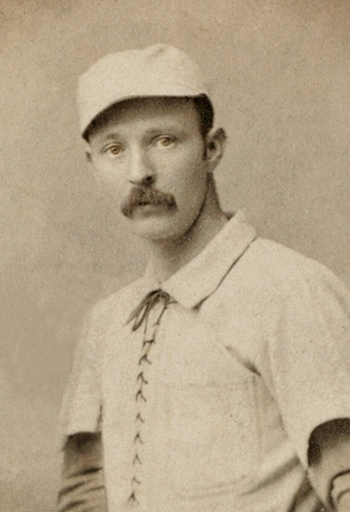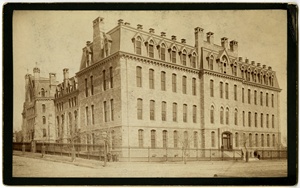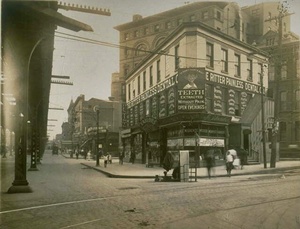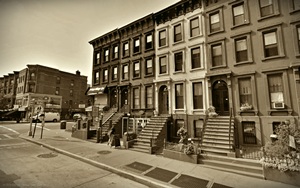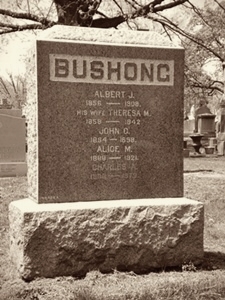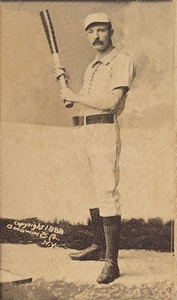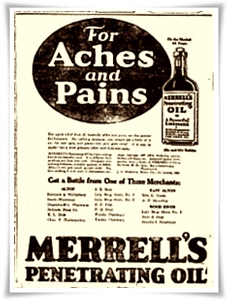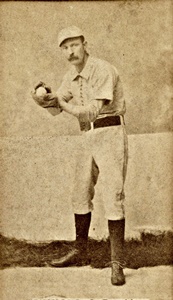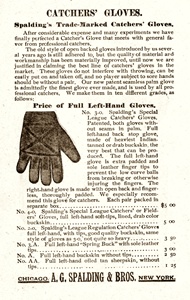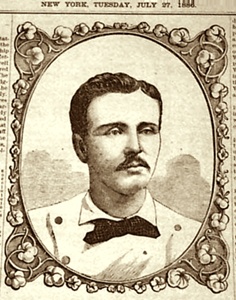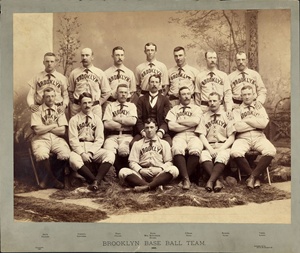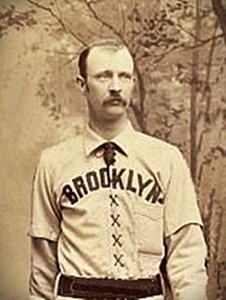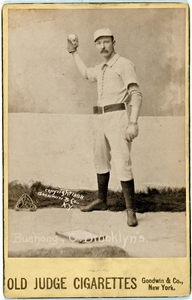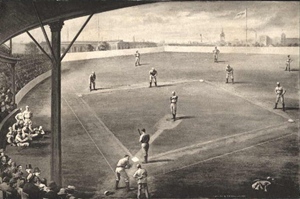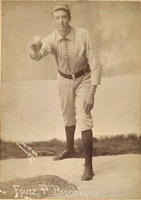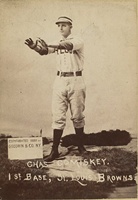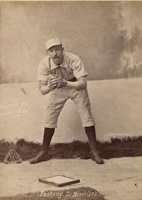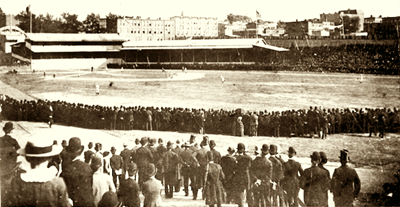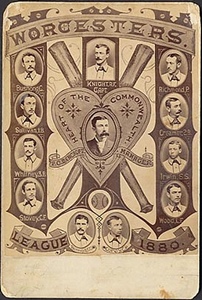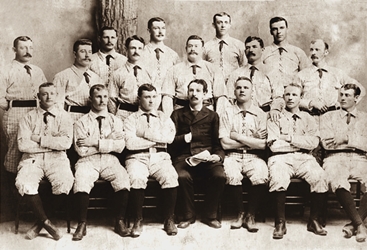
|















|
|
|
Albert John Bushong, D.D.S.
Doc Bushong, Catcher
by Rick Bushong
February, 2014
|
|
|
Albert Bushong graduated as a D.D.S. in 1882 from
the new University of Pennsylvania Dental Dept.
at Hare Hall.
|
|
Albert Bushong the Dentist
Albert John Bushong, DDS, (1856-1908), better known as "Doc Bushong"
was one of the most famous Major League Baseball catchers of the 19th century, and is one of a few actual celebrities in the Bushong family.
He was also a major contributor to the final
transformation of the catcher's mitt. Given the fact that he was an
accredited dentist from early 1882, and he played baseball
professionally for several years before graduation and about eight
after. He was obviously highly motivated to protect his
hands and save them for his dental profession.
BUSHONG LINEAGE: Albert John Bushong/Charles Augustus Bushong and Margaret Moore/
Andrew Bushong and Sarah Steinmetz/ Jacob Bushong and
Anna Elizabeth Rutter/ Hans Philip Bushong and Anna Eva Hergard/ Hans John Bushong (IV) and Barbara/ Hanss John Boschung (III) and Anna Maria Boschung of Switzerland, (immigrated before 1719)/ Hans Boschung (II) and Anna Stocker/ Hans Boschung (I) and Anna Anneler/ Michael Studer-Boschung and Dichti Jaggi. |
|
Albert John Bushong was born September 15, 1856, in Philadelphia, Pennsylvania, the son of Charles A. Bushong and Margaret Moore Bushong. He attended public schools in Philadelphia and graduated from Central High School in 1876.1, 2 After playing baseball in various minor league teams for a couple of years, he enrolled in 1878 in dental school at the University of Pennsylvania. Bushong was one of the first to matriculate in the brand-new Department of Dentistry and he received his D.D.S. in 1882.5 While attending dental school, he played professional baseball every year, catching in more than 230 games as well as "barnstorming" in the off-season with a different team, the Hop Bitters.2 Bushong was the first University of Pennsylvania graduate to play in Major League baseball. He did not play ball for the university, as he was already playing pro-ball.5 Shortly after graduation Albert J. Bushong and Theresa M. Gottery were married and together they had seven children.1 Their children: Stuart Franklin Bushong, January 23, 1885; Alice Bushong, August, 1886; Charles Albert Bushong, May 15, 1888; Beatrice, May, 1890; John D. Bushong, August 18, 1894; William Durrell Bushong, August 18, 1894; and Mary Bushong, June, 1899.
|
|
One of the dental houses in Brooklyn, the E. Ritter
Painless Dental Co., located at the intersection of Third Avenue, Schermerhorn Street, and Flatbush Avenue in
1908. Notice the Alfred E. Neuman
look-a like in the sign. |
|
Albert Bushong's home and business, 442 9th St.
Brooklyn, second from left, next to white building.
Google 2011 Street View. |
|
In 1891, at the age of 33, Doc retired from baseball and began practicing dentistry full-time. He started at a large dental parlor in
Hoboken, New Jersey and worked with his two younger brothers. Eventually he
became manager of the establishment.2 Also while working in Hoboken, he
began and, according to baseball historian William Rankin, "built up a
large and flourishing practice," at his home in south Brooklyn, 442
Ninth Street. On November 9, 1898 Bushong's four year old son, John, died after being severely burned in an election night bonfire, which were common rituals at the time.1, 2 Eventually all three of his surviving sons, as well as a
nephew, also became Brooklyn dentists and several worked at the Ninth Street, Bushong
family business, which was in operation as late as 1942.1 On August 19,
1908, Albert John Bushong died of cancer at his home, 442 Ninth Street,
Brooklyn, at the age of 51 and was buried in the Holy Cross Cemetery,
Brooklyn, New York.8, 12 Doc's home on Ninth St. is still there and the
bottom floor is now a bakery.
|
Noted Ball Player Dead
Albert J. Bushong, a noted catcher of the old St. Louis Browns baseball team and later a member of the Brooklyn team, is dead at his home, 442 Ninth Street, Brooklyn. At the time that Bushong came to the Brooklyn team which was late in the eighties, Charles H. Byrne, then President of the Brooklyn Club, obtained the release of "Al" Foutz and "Bobby" Caruthers, paying the St. Louis Browns $19,000 for the trio. Bushong was born in Philadelphia fifty-two years ago. Since his retirement from baseball in 1900 {1891} he had been a dentist.
The New York Times,
August 21, 1908.
|
Albert John Bushong has a memorial on Find a Grave and it can be seen here. Albert Bushong on FindaGrave.
|
|
Albert John Bushong's tombstone.
Photo by Tom Dusenbury, used with permission.
|
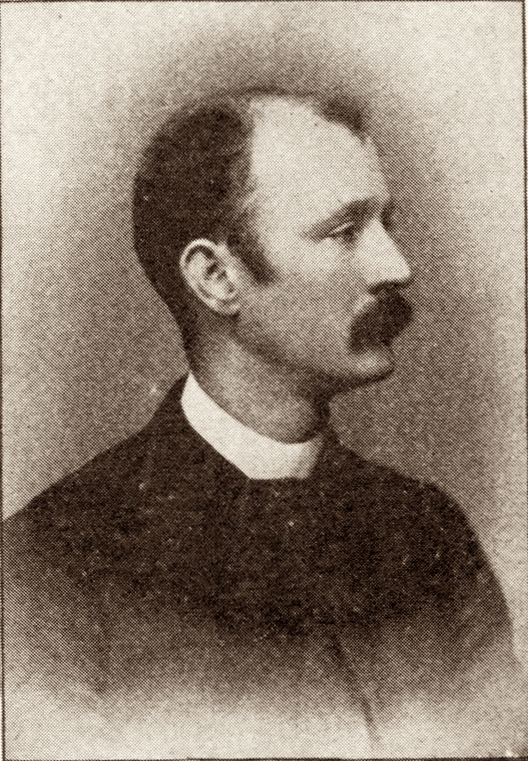 |
|
Albert Bushong's will written the month before he died....
In the Name of God, Amen, I Albert John Bushong of 442 Ninth Street, Brooklyn, New York, being of sound and disposing mind memory and understanding and conscious of the uncertainty of this life, do make publish and declare this to be my last Will and Testament, hereby revoking any and all other wills by me at any time heretofore made. First: I direct my executrix hereinafter named to pay all my just debts, funeral and testamentary expenses as soon after my decease as conveniently can be done. Second: I give devise and bequeath all the rest residue and remainder of my estate, real personal or mixed, of whatsoever kind and description and wheresoever situated, unto by beloved wife, Theresa M. Bushong.
Lastly: I hereby nominate and appoint my beloved wife Theresa M. Bushong to be the Executrix of this my Last Will and Testament.
In witness whereof I have this fourth day of July in the year of our Lord, Nineteen Hundred and eight.
Albert John Bushong (L.S.)
Witnesses
George F. Hickey
Emma R. Bushong
Subscribed, sealed, published and declared by the above named Testor, Albert John Bushong as and for his last Will and Testament in our presence and we at his request and in his presence and in the presence of each other have hereunto signed our names as witnesses this fourth day of July, Nineteen Hundred and eight.
George F. Hickey residing at 726 Union Street, Brooklyn, New York
Emma R. Bushong residing 213 W. Coulter St., Germantown, Phila, Pa.
|
|
Doc Bushong-Catcher
|
The baseball career of Albert "Doc" Bushong, spanned from 1875 to 1891, and during that time he played on various professional minor league and major league teams, including the...
- Brooklyn Atlantics (1875)
- Philadelphia Athletics (1876)
- Worcester Ruby Legs (1880–1882)
- Cleveland Blues, (1883–1884)
- St. Louis Browns (1885–1887)
- Brooklyn Bridegrooms (1888–1890)
Standing only five feet, nine inches and weighing as low as 135 pounds, Doc was best known for his control of the infield, and his meager batting statistics bear that out. His batting average was just .214, with only 184 runs batted in (RBI), and a grand total of 13 career Home-runs.2, 3 Some of his greatest seasons occurred in the latter part of his career, when he played on five pennant winning teams and was in post-season play five times. One of his more notable seasons is likely 1886, with the St. Louis Browns of the American Association, the year they won the Championship (later called World Series) against the Chicago White Stockings, in the National League. That year, for his part in the championship season, the Missouri Pacific Railroad, honored Doc and several other players by renaming some of their whistle-stop towns. The town of Weeks in Lyons County, Kansas, became, Bushong, Kansas.2, 4
|
|
Not known for his batting, Doc was best as a defensive asset. Possibly a little work on his grip might have helped, seen on this rare Old Judge Cigarettes Card photo.
|
|
Merrell's Penetrating Oil, for the cure
of Rheumatism, Sprains, Stiff Joints,
Lame Back, Neuralgia, Toothache,
pains in the Limbs, or pains in any
part of the system. Penetrating to the
very Bone. Good for horses, too. |
|
In 1887, Doc, along with his teammates on St. Louis Browns, became some of the first baseball players to do paid product endorsements. They appeared in an advertisement brochure for Merrell's Penetrating Oil, which was a cure-all for a long list of ailments.6, 7 Leading up to the 1888 season, Doc made news again, when Chris von der Ahe, owner of the St. Louis Browns, sold the contracts for him, along with pitcher "Parisian Bob" Caruthers, and first baseman/outfielder/pitcher Dave Foutz. The sale was to the Brooklyn Bride Grooms and their owner, Charlie Byrne who paid, what was then, the enormous sum of $19,000, for the trio.8
Doc continued playing, but on July 4, 1889, he injured his arm in the second game of a doubleheader in St. Louis, and played in only two more regular season games. In 1890, though the Brooklyn, Bridegrooms, again won the pennant, Doc's playing was limited. He never fully recovered from the injury, and the 1890 season was his last in the major leagues. He was officially released from the majors on March 26, 1891. But Doc wasn't quite ready to give it up and still wanted to play one more season. Within a couple of weeks of his release, Doc signed on with a minor league team and eventually played on two different teams, but his injury had robbed him of his throwing strength and speed. He didn't complete the season and was released in mid-July, 1891, ending his baseball career.2 Doc had played baseball, pro and semi-pro for fifteen years.
|
Doc and the Catcher's mitt
In a game that was traditionally played bare-handed, it is difficult to say who was first to make and use the padded catcher's mitt similar to today's glove. The first player to wear a glove was catcher Doug Allison, in 1870. In 1888, Joe Gunson described his catcher's mitt, and is sometimes associated with its invention, along with Doc Bushong and others. But his claim as first is brought into question by a newspaper article in the Brooklyn Eagle, that describes Doc with his special glove at least a season before Gunson's claim.6 But on July 1, 1887, while at bat in the sixth inning of a game against Louisville, Bushong's fingers were mashed by a wild pitch from Louisville switch pitcher Ice Box Chamberlain.9 The injury resulted in a broken finger and prevented him from playing for almost ten and a half weeks.6 But it is easy to believe that on September 18, 1887 when he returned, Bushong had seriously padded a mitt to protect his hand as well his dentistry profession. Further, an article in October 13, 1887, in the Brooklyn Eagle, tells of Bushong losing his old glove....
|
|
For a photo in 1887 or 1888, Doc is wearing an unpadded glove.
|
|
By 1889, Al Spaulding patented
this catcher's mitt for sale. It's
not padded much.
|
|
"he feels pretty badly over the matter.. it was padded and fixed up until it was as soft to his hand as a pillow and it was his best friend while he was up under the bat. It will take him some time to become accustomed to a new glove and it will be several seasons before he can get as many patches on the one he wears now as he had on the old one."
The Brooklyn Eagle
October 13, 1887
The photographs taken of Bushong, used for the 1888 season, on the Old Judge baseball cards, show him with thick gloves on both hands, but in 1889 Sporting Life magazine described his mitt as a spring mattress on his left hand.6 In the end, most agree that Bushong certainly deserves credit in the evolution of the catcher's mitt and with his known motivation to protect his hands, many believe that he was its primary inventor.
|
Doc Bushong the Gentleman
Doc was a beloved personality to the sports writers of the day as well as baseball fans, who considered him a gentleman. In 1913, five years after his death and decades after he retired from baseball they were still writing about him in this newspaper article that gives a little insight into his character.
"There were some of the old boys who stood as conspicuously for
their gentlemanliness as any today and one of these was the late Dr.
Albert J. Bushong, the great little catcher for Comiskey's old St. Louis
Browns. Bushong was quiet and cultured and did not oven swear. Frank
Bandle, county register of deeds, who was some catcher himself in the
days gone by, relates an interesting little anecdote that shows
Bushong's character. They were catching for opposing teams. Bandle had
hit safely and stole second and third, Bushong attempting in both
instances to catch him. As Bandle slid safely under the throw at third,
Bushong stood for a second and looked at him. and remarked in his quiet
way. "Bandle, dog-gone you, you'd steal from the devil." "And that was
so near to cursing for Al Bushong" said Bandle," that it occasioned loud
and general comment from all who heard it."
Omaha Daily Bee
Omaha, Nebraska
March 23, 1913
Sport Section, Page 3-S
|
|
Albert Bushong's portrait from an 1886, New York paper.
|
|
The 1889 Brooklyn Bridegrooms. Doc is back row, second from the right.
|
|
Following the 1889 World Series (it wasn't yet called the World Series), an incident occurred. That year, Doc's team, the Brooklyn Bridegrooms
lost the series, to the New York Giants. But in November, a telegram from Doc to the Giants' catcher Jocko Milligan was revealed. This is the telegram....
"To John Milligan, Catcher St. Louis Base Ball Club: Brooklyn, Oct. 19. {1889}
Friend Jack: Hope you will answer the telegram I sent you, which was
that I'll give $200 for your share in our agreement. It will be a
personal favor to me if you will, and besides will be a sure thing for
you and yet give me a chance to make a little. Don't lose your chance as
you did with Tucker. Reply instantly at my expense.
A. J. Bushong"
|
The telegram was referring to a scheme for a $400 prize to be given to the
individual winners of the series.2 The prize was an unofficial prize and had been offered by a chewing gum firm, likely the Green and Blackwell Company of New York, known as G and B Chewing Gum Co., who in 1888, were first to issue gum with their baseball cards.11 Doc's idea was Prize-sharing, where, before the actual games, they were to agree, the
winner would split the prize with the loser. Prize-sharing was common in
the day, and in numerous sports. It had been around in baseball for over
a decade.
But Doc's telegram was accidentally opened by Milligan's manager, who
gave it to the American Association management, and in their November meeting, the
telegram was used unsuccessfully in an attempt to try and stir up
anything to stop the Bridegrooms from leaving the American
Association to join the National League. The newspaper, The Sun (New
York) reported the association meeting, along with the telegram, November 16, 1889.10 That was the end of it. Though Doc was
embarrassed over the report, nothing else was said or printed about the
matter. The Bridegrooms did join the National League, and with them
went their prized catcher, Doc Bushong.2
|
|
Doc Bushong, photo extracted from
the 1889 group photo.
|
Doc Bushong's Control of the Infield
|
|
Albert "Doc" Bushong, throwing
ball, on an 1888 Old Judge baseball card.
|
|
All throughout Doc Bushong's baseball career, he was a highly respected
player, by owners, players, and the fans. That says a lot
about his infield presence and catching ability, because, as mentioned before, his batting statistics were not inspiring, to say the least. This leaves his catching, and less tangible, his intellect and personality as his
main assets. Here in 1888 future Hall of Fame pitcher, John Ward, discusses the value of good catchers and Doc's abilities...
There are some cases in which a steady, intelligent catcher is of more
worth to a team than even the pitcher, because such a man will make
pitchers out of almost any kind of material.... I
have no doubt that much of the success of the St. Louis pitchers has
been due to the steady support and judicious coaching of Bushong.
Source: Base-Ball How to Become a Player
Author: John M. Ward, Published 1888 Chapter 4
Considered, at the time, to be one of the smartest men
playing baseball, he probably was the highest educated. Doc
was an asset to every team he played on and years later the papers and fans were still
writing and talking about him.
This article, below, illustrates a great trick play by Doc and shows a little of how Doc controlled the infield, it was written in 1908, a few months after his death, but over 20 years after the event
actually happened...
|
Base Ball Dope
By the "Little Old Man"
(Elmer E. Bates)
There was a play on the old Cleveland grounds one afternoon in the way
back days (1883) about which the fans of the early '80s never tire of talking.
Never tire of talking about because, perhaps, "Pop" Anson ---always the
butt of the fans---was the victim ---and because, too, slender little
Doc Bushong, he of the lithe body, the white hands and the long,
tapering fingers, was the hero. In this particular game the pitchers
were one armed Hugh Daly and Fred Goldsmith, and the score, when the old
White Stockings went to bat in their half of the ninth Inning, was 2 to
1 in Cleveland's favor. Anson began the ninth with a single, and two
outs put him on third. Then up came old George Gore, who always bothered
Daly. Hugh handed up a couple of wide ones, and then "Doc" came to the
rescue.
Bushong began his share of the play by slamming the ball down to Mike
Muldoon at third again and again, in an apparent effort to catch Anson.
In the meantime Doc had wigwagged to Tom York, out in left field, to
come in close to third. Anson didn't see York when the latter sneaked in
from left. His eyes were on the plate, behind which little Bushong was
crouched. Suddenly "Doc" straightened up and shot the ball in Muldoon's
direction, falling down purposely as he made the throw. York was about
10 feet back of third as the ball went whizzing over Muldoon's head.
"Pop" dashed for the plate, but ere he got 30 feet up the line the ball
had been gathered in by York and sent straight as a rifle shot into
Bushong's hands. Anson had no chance to slide; no chance to return to
third; no chance to dodge the issue. He simply "walked into" the putout
as gracefully as possible, while the crowd roared its appreciation of
Bushong's great play.
The Spokane Press
Spokane, Washington
November 18, 1908
Page 6
| |
An early game in the Boston South End Grounds Baseball park, built in 1888. |
|
That game, though not stated, occurred in 1883, because that's the only
season Doc and pitcher Hugh Daly played together, and they were on
the Cleveland Blues. Three years later in 1886, for the St. Louis
Browns, Doc was involved in another brilliant play, that illustrates how he was in command of the infield, this time with the legendary pitcher, Dave Foutz.
|
The Greatest Play in the History of 19th Century Baseball?
The Participants
On Base for the
Louisville Colonels
- John Kerins (on second base)
- Pete Browning (on first base)
| ;
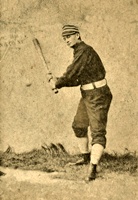 |
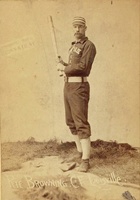
|
|
|
The Play
(During) "Sunday's game between St. Louis (and) Louisville, and in the
presence of 6,000 persons, Foutz played the sharpest trick ever seen on
the ball field. Browning was on first base and Kerins on second, with no
one out. Pete (Browning) played far off from the base, while Comiskey took a stand
back into right field. Pete had his back turned toward second base, and
was keeping an eye on the movements of Comiskey, while he eagerly
pranced back and forth to show the crowd that he was not afraid to steal
off a bag. Foutz pretended not to watch Browning, but suddenly Bushong
signaled, and Foutz dashed over toward first base with the ball in hand,
touching Browning before the latter knew what had happened. Such a play
was never before seen, and the spectators howled with delight. Pete was
mighty mad, and, as he has a faculty for being caught napping, the play
was doubly embarrassing."
The Sporting News
September 13, 1886
|
|
|
The Brooklyn Grays, (later the Bridegrooms) at Washington Park (#1),
their home field, May 30, 1887, Decoration Day.
|
|

|
|
With this, Dave Foutz was credited with an unassisted pick-off, in a play that has been called the greatest play of 19th century baseball, and is probably the only unassisted pick-off ever recorded by a pitcher. While Foutz received credit for the pick-off, unassisted doesn't really describe how it happened. I submit
that, The Sporting News, missed the real master-mind of the play,
Doc Bushong, especially in light of his past infield
wizardry, including the trick play of 1883, mentioned above.
First, it might be remembered, in 1886, Doc was in top form and he and Dave Foutz had already been playing together for a couple of seasons. Further Doc, Foutz, and rest of the St. Louis Browns ended up winning the World Series that year. Then, notice the play is orchestrated by Doc Bushong, who was obviously in control of the whole event, because he was the one who was watching Browning. Foutz, on the
other hand, had his back turned and had his eyes on Doc. It was Doc who gave the signal to
Foutz. So in telling Foutz to tag out the runner, Doc initiated the
play, therefore, he was its creator. It's no wonder, with this kind of
infield awareness, Doc Bushong was considered one of the smartest men
playing baseball. And if, as suggested, this play is the greatest play in the history of 19th century baseball, then Albert "Doc" Bushong should be remembered as its architect.
|
References:
- Search the Bushong United Family tree
- Doc Bushong at the SABR Bio Project, by Brian McKenna
- Omaha Daily Bee, August 06, 1911, Sporting Section, Page 4, Robert "Bobby" Caruther's Obituary
- Wikipedia, Bushong, Kansas
- University of Pennsylvania Alumni Profiles
- When the Dodgers Were Bridegrooms: By Ronald Shafer Pages. 62–65. ISBN 0786458992
- Chris Von Der Ahe and the St. Louis Browns, By J. Thomas Hetrick Page 69
- The New York Times, August 21, 1908 "Noted Ball Player Dead"
- St. Paul Daily Globe, July 02, 1887
- The Sun, New York, New York, November 16, 1889, Page 4
- A Brief History of Baseball Cards
- Find a Grave Doc Bushong
Further Reading:
|
|
Additional baseball cards and photographs with Doc Bushong
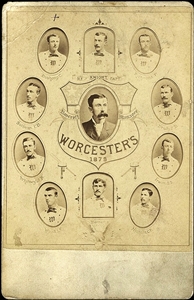 | |
| |
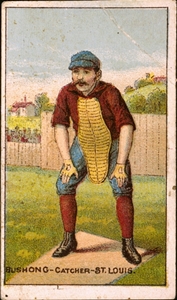 |
The 1878 Worcester Ruby Legs.
Doc, upper left. | |
The 1880 Worcester Ruby Legs.
Doc, upper left, was not catching
on June 12, 1880, when Worcester
pitcher Lee Richmond, upper right,
threw the first perfect game in
major league history. | |
A.J. Bushong on an 1887
baseball card.
|
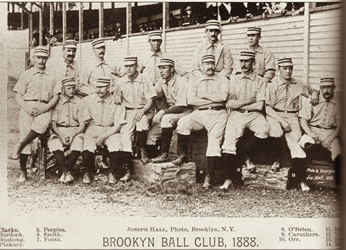 |
|
| |
The 1888 Brooklyn Bridegrooms. Doc Bushong is in the back row
between Burdock (with the large mustache) and
Dave Foutz (no mustache) |
|
The Brooklyn Bridegrooms early in the 1888 season, probably April 1888.
From left to right, front row, (seated): Pinkey, Silich, Hughes, McCunnigle, Smith, Mays.
Middle row: McClellan, Peoples, Caruthers, Orr, Holbert, Bushong.
Back row: Clark, Terry, Foutz, and O'Brien. | |
|
Bushong United is Copyright ©2014, 2017, 2019, 2023 by
Rick Bushong any Commercial Use is Prohibited.
Non-commercial use is allowed with permission or only if entire
copyright is included.
Photographs, unless otherwise noted, are in the commons, and are free use. No Bandwidth Theft Allowed.
To Direct Search the Bushong United Family Tree click here
|

